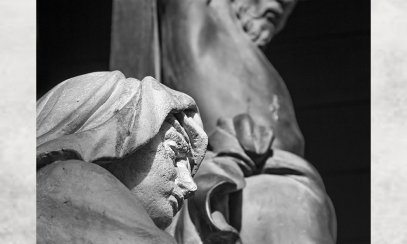
Not your regular Santa Claus
St. Nicholas of Myra, whose feast day is on December 6, is connected to our celebration of the birth of Jesus Christ in two important traditions. The most familiar tradition for us associated with St. Nicholas is the giving of gifts on his feast day and in celebrating Christmas. This tradition originates with the story of St. Nicholas using his inheritance to provide a bag of money and jewels for each of three sisters to be married to save them from a life of prostitution because their father was too poor to provide a dowry for them.
St. Nicholas of Myra, whose feast day is on December 6, is connected to our celebration of the birth of Jesus Christ in two important traditions. The most familiar tradition for us associated with St. Nicholas is the giving of gifts on his feast day and in celebrating Christmas. This tradition originates with the story of St. Nicholas using his inheritance to provide a bag of money and jewels for each of three sisters to be married to save them from a life of prostitution because their father was too poor to provide a dowry for them.
The lesser-known tradition associated with St. Nicholas, the fourth-century Bishop of Myra in modern-day Turkey, is his presence at the First Council of Nicaea in 325 A.D., 1700 years ago this year. This council was convened to address the heretical teachings of the priest Arius that Jesus Christ was not divine and existing for all eternity, but rather a creature that was created “from another substance than that of the Father.” (Catechism of the Catholic Church 465) This tradition holds that at the Council of Nicaea, St. Nicholas struck the heretic Arius in the face as a sign of his disagreement with Arius’ teaching. The bishops at this Council debunked Arius’ heresy by affirming Jesus to be eternally divine and fully human, “begotten, not made, consubstantial with the Father” in the first version of the Nicene Creed. At the Council of Constantinople in 381, the bishops added the roles of the Holy Spirit and Mary to the Nicene Creed: “and by the Holy Spirit was incarnate of the Virgin Mary, and became man,” as we pray at Mass today.
Christmas celebrates the birth of Jesus Christ, God incarnate, whose life, death, and resurrection provide hope for every human person striving to live and grow as a disciple of Jesus.
Jesus Christ the Son of God becoming incarnate — the hypostatic union of God and man affirmed at the Council of Nicaea — is God’s divine and eternal plan leading to the redemption of humankind from the original sin of Adam. As St. John wrote so clearly: “For God so loved the world that He gave His only Son, so that everyone who believes in him might not perish but might have eternal life.” (Jn 3:16) The Incarnation of Jesus, the Son of God, leading to the act of salvation from sin that only Jesus could accomplish, is evidence of God’s perfect love and desire for humankind to flourish. St. Paul attests: “For just as through the disobedience of one person the many were made sinners, so through the obedience of one the many will be made righteous.” (Rm 5:19)
From all eternity, God knew that His divine plan for creation, giving to man and woman the free will to choose, would result in man turning away from following his perfect will and needing to be saved. The Son of God became flesh so that we “may come to share in the divine nature.” (2 Pt 1:4) The human person created in the image and likeness of God and sharing in his divinity is the cornerstone of our Catholic Social Teaching.
In Michelangelo’s inspired painting of God’s creation of man on the ceiling of the Sistine Chapel at the Vatican, he provides a preview of the Incarnation. In the scene of God creating and giving life to Adam, God’s left arm is wrapped around a woman thought to be Eve, with his left hand pointing to a child. (See image in the center panel on page 29.) Catholic art historian Dr. Elizabeth Lev explains this scene as portraying the child under God’s left hand as Jesus, the Son of God. God knew that Adam and Eve would not choose to conform their wills to God’s will for living in his creation. God’s plan from all eternity was that this child, the Son of God incarnate, would redeem humankind.
We often think of St. Nicholas and his association with Christmas. Let’s also remember and give thanks for St. Nicholas and his brother bishops at the Council of Nicaea, who 1700 years ago were clearly led by the Holy Spirit to preserve the truth of the totally divine and totally human natures united in Jesus, the incarnate Son of God.
St. Nicholas of Myra, pray for us.
Deacon James Kasprzak is the secretary of the Diocesan Commission on Catholic Social Teaching.



